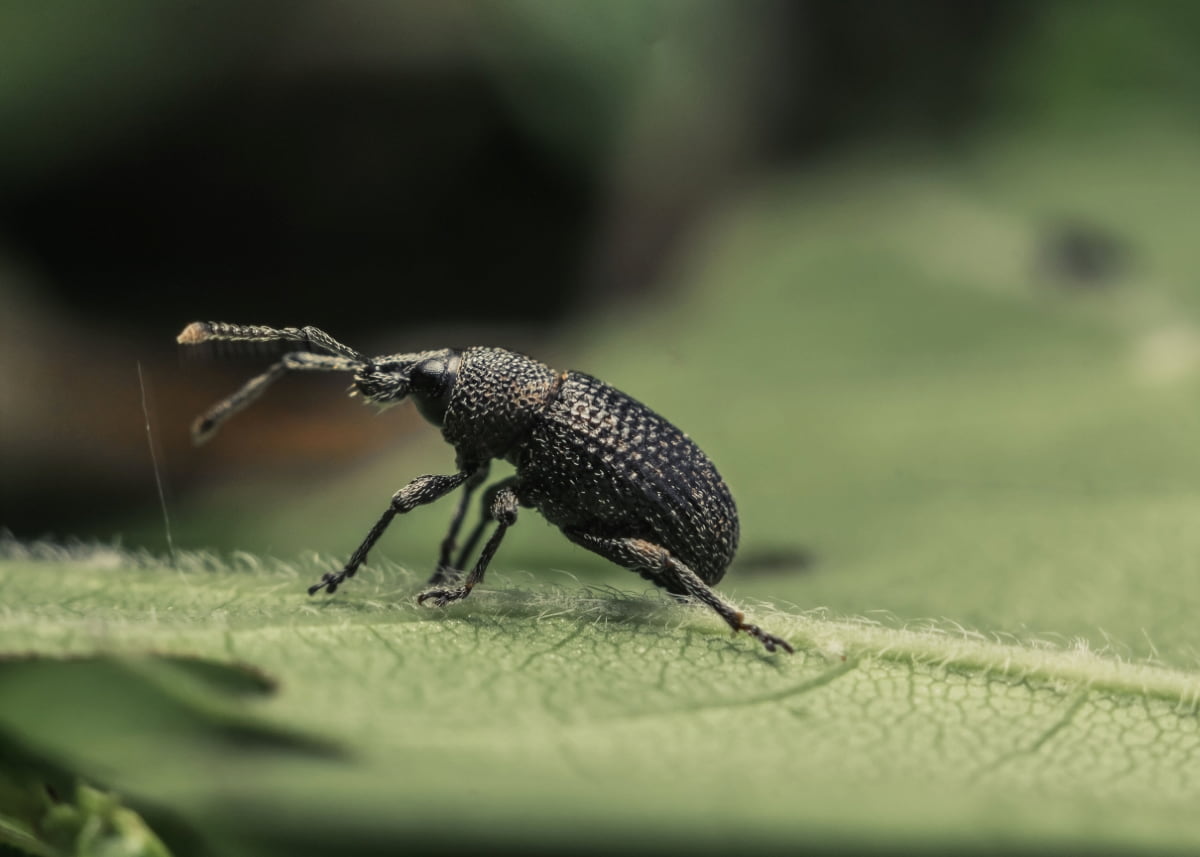Weevils, small bugs ranging from 0.125 to 0.25 inches in size, can be a nuisance in lawns. Identifying and addressing these pests promptly is crucial for maintaining a healthy lawn. Fortunately, natural methods can effectively control and eliminate weevils, minimizing the need for chemical interventions. By understanding their characteristics and behavior, implementing natural predators, and fostering a balanced ecosystem, you can tackle weevil infestations sustainably.

How to Get Rid of Weevils in Lawn Naturally
Understand and Identify Weevils in Your Lawn
Weevils, at 0.125 to 0.25 inches or 3 to 6 millimeters in size, present a unique challenge in lawn care. Recognizable by their pear or light bulb-like shape, these insects possess a distinctive long and slender snout protruding from their heads. With six legs and folded antennae, weevils can wreak havoc on lawns if left unchecked. Identifying these pests is crucial for effective control and treatment. Once their presence is confirmed, it’s essential to explore natural methods that not only eliminate the immediate infestation but also promote a balanced ecosystem in your lawn.
Natural Predators of Weevils: Encouraging Beneficial Insects
By encouraging beneficial insects that prey on weevils, you create a natural and sustainable balance in your ecosystem. Ladybugs, ground beetles, and predatory nematodes are among the most effective natural predators of weevils. Introduce these allies to your lawn to help keep weevil populations in check.
Ladybugs, with their voracious appetite for weevil larvae and eggs, are particularly valuable. Ground beetles, known for their nocturnal hunting habits, actively seek and consume adult weevils during the night. Predatory nematodes, microscopic organisms, attack weevil larvae in the soil.
Cultural Practices for Weevil Control: Maintaining Lawn Health
Regularly mowing your grass to the recommended height helps reduce weevil-friendly environments, as these pests thrive in tall grass. Aeration improves soil drainage, making it less attractive to weevils. Avoid overwatering, as moist conditions favor weevil infestations. Opt for proper fertilization, promoting strong grass growth that can withstand weevil damage. Additionally, cleaning up debris and thatch eliminates potential weevil hiding spots. By adopting these cultural practices, you not only enhance the overall health of your lawn but also create an environment less conducive to weevil proliferation.
Organic Insecticides for Weevil Management: Safe and Effective Options
Neem oil, extracted from the neem tree, disrupts weevil feeding and reproduction while being harmless to beneficial insects. Diatomaceous earth, composed of fossilized algae, damages weevil exoskeletons, dehydrating and ultimately killing them. Spinosad, a microbial insecticide, targets weevil larvae without harming beneficial insects.
In case you missed it: How to Get Rid of Lawn Worms with Natural Methods: Beginners Guide

Bacillus thuringiensis (Bt), a bacterium, specifically targets weevil larvae, providing targeted control. These organic alternatives avoid the negative impacts associated with synthetic chemicals, preserving the ecological balance in your lawn. When applying organic insecticides, follow recommended guidelines to maximize efficacy while minimizing environmental impact.
Beneficial Nematodes for Weevil Control: Using Biological Solutions
Beneficial nematodes offer a biological solution to weevil control. These microscopic roundworms parasitize weevil larvae in the soil, preventing them from maturing into damaging adults. Apply nematodes to your lawn in the evening or on cloudy days, as they are sensitive to UV light.
Steinernema and Heterorhabditis are common species of beneficial nematodes effective against weevils. Introduce them to the soil when weevil larvae are active, typically in spring or early summer. Keep the soil consistently moist to facilitate nematode movement and target weevil larvae effectively. Using beneficial nematodes not only provides targeted control but also aligns with sustainable and environment-friendly practices.
Companion Planting to Deter Weevils: Harnessing Plant Relationships
Utilizing this method can contribute to weevil control in your lawn. Plants such as marigolds, garlic, and chives release compounds that repel weevils, creating a natural deterrent. Interplanting these companion plants with susceptible lawn grasses can help minimize weevil infestations.
Marigolds, with their strong aroma, act as a natural insect repellent. Garlic and chives, known for their pungent scents, can deter weevils from settling in your lawn. Consider planting these companion plants in and around your lawn borders or interspersed throughout your garden to create a weevil-resistant environment.
Soil Amendments for Weevil Prevention: Creating an Unfavorable Environment
Adjusting soil conditions through amendments is an effective strategy for preventing weevil infestations. Weevils prefer moist and compacted soil, so improving drainage and soil structure can create an unfavorable environment for them. Incorporate organic matter like vermicompost or aged manure to enhance soil structure, promoting aeration and reducing moisture retention. Adding sand or perlite can further improve drainage, making the soil less attractive to weevils.
In case you missed it: How to Get Rid of Lawn Pests with Homemade Sprays: DIY for Controlling Lawn Pests

Additionally, avoid excessive nitrogen fertilization, as it can stimulate lush grass growth, providing an ideal habitat for weevils. Instead, focus on balanced fertilization to maintain healthy grass without promoting excessive succulence. Regularly testing and adjusting the pH of your soil to levels suitable for grass but unfavorable for weevils is crucial. Weevils prefer slightly acidic to neutral soil, so maintaining a pH slightly above or below their preference range can help deter these pests.
Physical Barriers and Traps for Weevil Management in Your Lawn
Creating physical barriers and employing traps can be effective in managing weevils on your lawn. Collars made of cardboard or other materials should be placed around young plants to prevent weevils from climbing up and feeding on them. Applying a layer of diatomaceous earth around susceptible plants creates a barrier that damages weevil exoskeletons, deterring their movement.
Utilizing burlap traps soaked in molasses or beer can attract and trap adult weevils. Install these traps near affected areas, and regularly check and dispose of captured weevils. This method helps reduce the adult population and prevents them from laying eggs on your lawn.
Natural Repellents for Weevils: Plant-Based Solutions
Harness the power of plant-based solutions to repel weevils from your lawn naturally. Certain herbs and aromatic plants possess properties that deter these pests. Planting mint, tansy, or basil in and around your lawn creates a natural barrier against weevils due to their strong scents. The aromatic oils released by these plants act as repellents, making the environment less favorable for weevil infestations.
Consider interspersing these repellent plants throughout your lawn or placing them strategically near susceptible areas to enhance their effectiveness. Embracing plant-based repellents not only safeguards your lawn from weevils but also adds fragrance and diversity to your outdoor space.
Integrated Pest Management for Weevil Control in Home Lawns
Begin by accurately identifying the weevil species present and monitoring their populations regularly. Utilize cultural practices like proper mowing, aeration, and crop rotation to create an environment less conducive to weevils. Incorporate natural predators such as ladybugs, ground beetles, and beneficial nematodes to control weevil populations actively. Employ companion planting to deter weevils through strategic plant relationships. When needed, apply organic insecticides, like neem oil or diatomaceous earth, to target specific stages of the weevil life cycle without harming beneficial insects.
In case you missed it: How to Get Rid of Armyworms in Lawn Naturally: Control and Treatment

Conclusion
In conclusion, managing weevils in your lawn naturally involves a multifaceted approach. The above-discussed strategies ensure effective control without harming the environment. By fostering a balanced ecosystem and embracing natural repellents, you can enjoy a lush and weevil-resistant lawn while promoting sustainable and eco-friendly lawn care practices.
- Deworming Schedule for Dogs/Puppies: A Beginners Guide
- How to Prevent and Control Parasites in Goats
- Beneficial Insects in Pest Management
- Natural Solutions for Pest Control in Flower Gardens
- Types of Fungicides Used in Agriculture
- Common Issues in the Fruit Development Stage of Pomegranate Farming
- Fruit Development Issues in Papaya: Easy Solutions and Treatment
- Soil-Borne Diseases and How to Protect Your Plants
- Practices to Prevent Disease Spread in the Garden